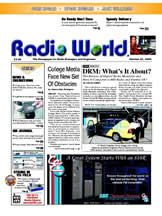|
Mike Murrey hired on as engineer at WJMC(AM/FM) and WAQE(AM/FM)
in Rice Lake, Wis., back in 1998. He took one look at the
459-foot tower serving WJMC on 1240 kHz and knew it would need
to be replaced someday. Well, that someday came in late
2019 when a crew refused to climb the 63-year-old structure.
That started a chain of events to replace the tower.
Heavy and consistent rains made site preparation exceedingly
difficult. Temporary roads were built with rock and gravel so
concrete could be poured at the new tower base and guy anchor
points. The original concrete could not be used because towers
are now “engineered” so they can be insured by insurance
companies.
It was beginning to look like the project would extend into 2020
when the tower crew announced they were starting “right NOW” to
take the old tower down. Rather than disassemble the old tower a
section at a time, they elected to cut a guy anchor and let ’er
fall. (Watch
the video.) People were evacuated from the
studio/transmitter building and a nearby business for the tower
to come down. Besides, who would want to be inside working while
a spectacle was going on outside?
Hurry
It had been assumed that there would be more than enough time to
put up a temporary AM transmit antenna, but now there was a
scramble to make it happen. Mike’s original plan was to
have two utility poles put up to support a long-wire antenna. My
experience with horizontal wire antennas is that they make good
“cloud burners,” as we say in the amateur radio hobby — RF
radiation tends to go up rather than out to the horizon. I found
that to be the case when helping another station. The coverage
with a quarter-wavelength wire, from the tower base to a tree,
went only a few miles. Ouch!
Details
A better choice was to erect the tallest possible temporary
vertical antenna. The local power company installed a used
40-foot utility pole with 35 feet sticking out of the ground as
shown in the image at the beginning of this article.
Topping that was 40 feet of pipe bolted to the pole. A wooden
dowel was inserted inside the bottom pipe section to keep it
from crushing when mounting bolts were tightened down. There was
a fair amount of pole to pipe overlap. The top turned out to be
only 68.5 feet above the ground.
The pole consisted of four 10-foot sections of iron plumbing
pipe, reducing from the bottom 1-1/4 inch to 1/2 inch at the
top. To help with antenna efficiency, Mike constructed a “top
hat” of three 10-foot wires, at the top, attached to nylon guy
lines. These wires were bare #10 soft-drawn copper. It was the
same wire that is normally used in AM ground systems. They
helped make the electrical height of the antenna a bit taller. A
#6 stranded copper wire ran down the wooden pole from the metal
pipe at the top. The wire was connected to a used/temporary
antenna coupling network at the bottom. Four 200-foot copper
radials were run out from the base on top of the ground. Some
half-length radials were also run bercause there was extra wire
available on the supply reel. Might as well use it.
Things didn’t go exactly as hoped (Fig. 2).
|



